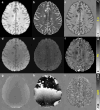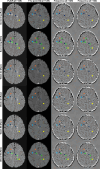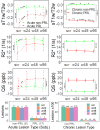Longitudinal Multiparametric Quantitative MRI Evaluation of Acute and Chronic Multiple Sclerosis Paramagnetic Rim Lesions
- PMID: 39239775
- PMCID: PMC11896925
- DOI: 10.1002/jmri.29583
Longitudinal Multiparametric Quantitative MRI Evaluation of Acute and Chronic Multiple Sclerosis Paramagnetic Rim Lesions
Abstract
Background: Multiple sclerosis (MS) paramagnetic rim lesions (PRLs) are markers of chronic active biology and exhibit complex iron and myelin changes that may complicate quantification when using conventional MRI approaches.
Purpose: To conduct a multiparametric MRI analysis of PRLs.
Study type: Retrospective/longitudinal.
Subjects: Ninety-five progressive MS subjects with at least one persistent PRL who were enrolled in the CONSONANCE trial.
Field strength/sequence: 3-T/Susceptibility-weighted, T1-weighted, T2-weighted, and fluid-attenuated inversion recovery.
Assessment: Acute/chronic PRLs and non-PRLs were measured at screening, 24, 48, and 96 weeks using quantitative magnetic susceptibility (QS), R2*, and standardized T1w/T2w ratio (sT1w/T2w). PRL analyses were performed for whole lesion, core, and rim. The correlations between PRL core and rim sT1w/T2w, QS, and R2* were assessed.
Statistical tests: Linear mixed models. A P-value <0.05 was considered significant.
Results: There was a significant decrease in sT1w/T2w (-0.24 ± -5.3 × 10-3) and R2* (-3.6 ± 2.2 Hz) but a significant increase in QS (+21 ± 1.3 ppb) using whole-lesion analysis of chronic PRLs compared to non-PRLs at screening. Tissue damage accumulated at the 96-week time point was more evident in acute/chronic PRLs compared to acute/chronic non-PRLs (ΔsT1w/T2w = -0.21/-0.24 ± 0.033/0.0053; ΔR2* = -4.4/-3.6 ± 1.4/2.2 Hz). New, acute PRL sT1w/T2w significantly increased in lesion core (+4.3 × 10-3 ± 1.2 × 10-4) and rim (+5.6 × 10-3 ± 1.2 × 10-4) 24 weeks post lesion inception, suggestive of partial recovery. Chronic PRLs, contrastingly, showed significant decreases in sT1w/T2w over the initial 24 weeks for both core (-2.1 × 10-4 ± 2.0 × 10-5) and rim (-2.4 × 10-4 ± 2.0 × 10-5), indicative of irreversible tissue damage. Significant positive correlations between PRL core and rim sT1w/T2w (R2 = 0.53), R2* (R2 = 0.69) and QS (R2 = 0.52) were observed.
Data conclusion: Multiparametric assessment of PRLs has the potential to be a valuable tool for assessing complex iron and myelin changes in chronic active PRLs of progressive MS patients.
Level of evidence: 2 TECHNICAL EFFICACY: Stage 3.
Keywords: R2* mapping; T1w/T2w; iron; myelin; paramagnetic rim lesions; quantitative susceptibility mapping.
© 2024 The Author(s). Journal of Magnetic Resonance Imaging published by Wiley Periodicals LLC on behalf of International Society for Magnetic Resonance in Medicine.
Conflict of interest statement
A.M.E. is a part‐time employee of NeuroRx Research. D.A.R. reports no competing interests. C.E., D.F., D.A. and Z.K. are employees of NeuroRx Research. S.N. has received research funding from Roche (not related to the current study), is a consultant for Sana Biotech, has received a speaker's honorarium from Novartis Canada, and is a part‐time employee of NeuroRx Research. D.L.A. received personal fees for consulting from Biogen, Eli Lilly, EMD Serono, Frequency Therapeutics, Gossamer Bio, Merck, Novartis, Race to Erase MS, Roche, and Sanofi‐Aventis, and has an ownership interest in NeuroRx Research.
Figures






References
-
- Coffman CH, White R, Subramanian K, Buch S, Bernitsas E, Haacke EM. Quantitative susceptibility mapping of both ring and non‐ring white matter lesions in relapsing remitting multiple sclerosis. Magn Reson Imaging 2022;91:45‐51. - PubMed
MeSH terms
Grants and funding
LinkOut - more resources
Full Text Sources
Medical
Research Materials

